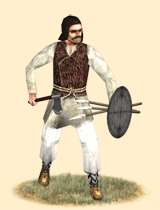Kôfyârên-î Verkhânâ (Hyrkanian Hillmen)
 |
Weapons | Defence | Mental | ||||||
|---|---|---|---|---|---|---|---|---|---|
| Primary | Secondary | Armour: | 1 | Morale: | 15 | ||||
| Type: | spear | axe | Shield: | 2 | Discipline: | impetuous | |||
| Attack: | 5 | 9 | Skill: | 12 | Training: | untrained | |||
| Charge: | 8 | 8 | Recruitment | Other | |||||
| Lethality: | 1 | 0.165 | Soldiers: | 50 | Hit Points: | 1 | |||
| Range: | 45 | 0 | Cost: | 1796 | Mass: | 1.05 | |||
| Ammo: | 3 | 0 | Upkeep: | 449 | |||||
| Turns: | 1 | ||||||||

These Hyrcanian hillmen are a fierce assault infantry, at their esse in guerilla warfare, using little more than vicious axes and the traditional Northern Iranian toughness to their disposal.
Hardy
Sapping Ability
Kôfyârên-î Verkhânâ, or Hyrcanian Hillmen are bands of warriors from the various clans in Hyrcania (Northern Iran, by the shores of the Southern Caspian Sea). These men are highly adept at guerrilla warfare and can serve a general, be he Hellene or Iranian, as fierce light infantry. They wear simple tunics and are armed with spears, axes and shields. They are fierce warriors and will give a good account of themselves, but more elite, disciplined infantry will come better out of it in combat. They represent the basis of the later elite Deilamite infantry who fought like heavy infantry, often pitted against the finest Roman infantry, during the later Byzantine-Persian wars. While the current Hyrcanian hillman begs to differ from the green-clad and sometimes heavily armoured Deilamites of Sassanid times, their weapons of choice remained essentially the same, where their distinguished traditional skills with the tabarzin (Axe) was retained, their javelins developed into a fierce two-pronged combat spear attached to thongs for both skirmishing and melee, and their simple shields developed into a large, oval and brightly painted shields. These men were also given longswords in Sassanian times making them a very versatile infantry, and indeed Sassanian combat infantry where hallmarked by versatility, being equipped for both melee and skirmishing. Usually at the sacrifice of elaborate armour.
Historically, the northern Iranian highlands are known for their hardy mountaineers who held all transgressors at bay. These men of the mountains were lightly ruled by all Persian Grandees who valued their warrior skills over what meagre income their mountain homes might bring. These men would be recruited from the warlike Gîlânî and Dailamî tribesmen of Verkhânâ (Hyrcania), and other similar peoples of northern Media. The earliest origins of these people are unknown, although the Dailamites could be the descendants of such ancient peoples as the Delumïoi (Delumioi) and Karduchoi (Kadousioi or the Cadusians) mentioned by Ptolemy in 2 AD. Classical historians mention Dailamites, 'Dolomites' or other very similar names repeatedly and their name is particularly mentioned in context with the later Byzantine Varangian Guard. Due to the mingling of migrant tribes with the indigenous residents of the region, several new clans were formed, of which, the two tribes of 'Gill' and 'Daylam' formed a majority. In the 6th century BC, the inhabitants of Gîlân allied with Kûroush (Cyrus) the Great and overthrew the Medes helping to establish the Achaemenian Persian Empire. Hyrcania itself was mainly rough and hilly which in turn (and also because it was relatively poor) meant the nomads of the Central Asian steppes bypassed it. The Hyrcanians themselves controlled the mountain passes in the region and it seems the different steppe peoples made arrangements with the Hyrcanian rulers to use these passes when they went raiding, often to fall upon peoples the Hyrcanians disliked, and also when retreating back to the steppes. Hyrcania was more or less independent during Seleukid rule (Dubbed “Hyrkania” according to Hellenic naming conventions), while under Pahlavan rule the Pahlava took more direct control, which was the reason the Hyrcanians were often in revolt and Hyrcania was considered an unruly area.